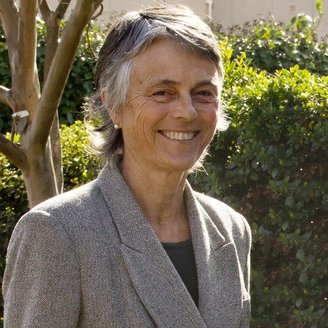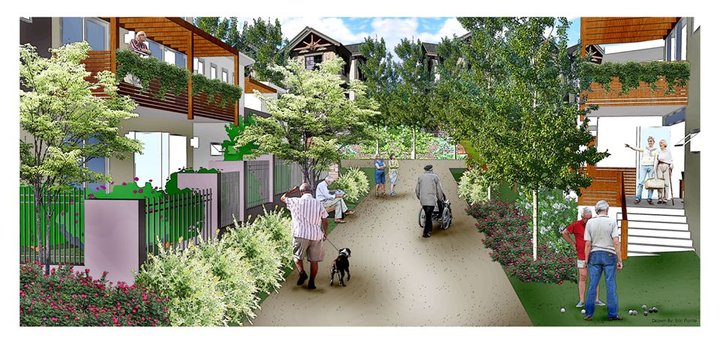
Ann Lindsay MD
Ann Lindsay MD served as Humboldt County Public Health Officer from 1994 to 2011 and, after moving to Stanford to develop and set up a primary care clinic, is living back in Humboldt and working on plans for the the Life Care Humboldt project — a large-scale, non-profit senior care community proposed for Humboldt county.
In a recent phone conversation with the Outpost, Lindsay explained the idea behind Life Care Humboldt and life plan communities and why she thinks there is a need for this type of facility in Humboldt. Lindsay also answered questions about how she, as a previous public health officer, feels Humboldt is dealing with the COVID-19 pandemic.
The following transcript of that conversation is edited for grammar, clarity and length.
Could you start by explaining how this type of development works? How is it different from assisted living facilities?
There’s a slightly different emphasis — to have independent living, assisted living, memory and advanced nursing care integrated in one community. We have a lot of facilities, some fine facilities here. But we did some demographic research and there’s still potential for building more. Currently the nearest life plan communities are in Medford and in Santa Rosa. So a number of people have left Humboldt County after living here and relocated just to get that kind of service.
The other thing is that in non-profit life plan communities the residents have more control over and more input in the activities, conflict resolution and all of that. There’s professional management and a board. But what people want to do is determined by who’s there.

Illustration of a life care facility from Life Care Humboldt’s Facebook page.
So, why is a model like this really beneficial to the seniors living there compared to the other types of care facilities that we already have here?
If you’re independent, you don’t have to move very far, you’re still in the same community when you need more services, or if your partner, your spouse, needs more services.
A friend of mine moved to Medford to be in the [life plan] community there because her husband had Alzheimer’s and there wasn’t an option for her to live independently and be close to an Alzheimer’s care facility. Whereas in a life plan community it’s all there, within a couple hundred yards.
It looks like the project is still in the really early planning stages right now. Your progress report said you are currently examining several potential site locations. Could you say where those are specifically?
We’ve looked at maybe six properties now. We need at least 15 acres. Part of the vision is to have a 3 or 4 acre farm and to have that generate some of the food. Like Potawat for the Mad River Hospital in Arcata.
We spoke to Dan Johnson [owner of local construction firm Danco] about Samoa. He spent 18 years getting all the permitting to develop Samoa. So, that’s a possibility.
One we’re favoring is in McKinleyville town center. There’s 47 acres owned by Anne Pierson, and there’s a community planning process going on there now. Having a senior life plan community there, which is a medium density housing, would fit in with that plan. I think it would really enhance the community development there. One of the plans is to have shops with residential units above. And with a lot of seniors living right there, that would be a real push for the shops. Seniors would love to have someplace where they can just walk to or take a golf cart or bike to and get their needs met.
I’m curious how the pandemic has affected planning for this project. Do you still see a model like this as practical, you know, with potential new health and safety standards continuing into the future?
I think all of us seniors now have had a real taste of what it’s like to be isolated in our own homes. And it can be quite lonely. So I think that there are ways to be safe and supported in an independent living community. The services you would need are right there. They’ve adapted and boosted technology in these other communities to help connect people and monitor their safety in an effective way.
Initially we did some human-centered design research, so we interviewed 14 people for two hours about their experience getting older or their parents and family, people they know, just to see what their issues are and how a life plan community could assist that. And an interesting thing is that the majority of people we interviewed didn’t like to think about aging and really didn’t have much of a viable plan. So, we felt like we needed a chance to talk to people more about life plan communities and the options. We were planning to have house parties, but COVID turned them into Zoom parties. So we’d have six or eight people for an hour and we’d talk about life plan communities. We’d talk about their values and how we could help realize those values. We got some great input.

We also, on our website, have a design survey that people can complete to give us input on what their preferences might be for services and appearance which is really important. I mean, we’re gonna have to spend a lot of money and hire consultants who are skilled at setting up these communities. But the more grassroots input we get from people, the more likely we’re going to have a good fit for Humboldt County. And that’s sort of the spirit that’s coming out of the Zoom parties is “let’s do it the Humboldt way.”
Great. So I thought I would ask a little about your history here. I know you were the public health officer here for 18 years. Why did you leave?
Well, my husband Alan Glaseroff is also a family practice doctor and we got a fabulous offer from Stanford to set up a clinic for Stanford employees and their dependents who are the highest cost, who have the most complicated health conditions and cost of health plan the most money. And so we set up a fabulous primary care clinic [Stanford Coordinated Care] with integrated services right there and people loved it. The patients loved it, and we reduced emergency room admissions 59% and hospital admissions 29%. And, you know, had really good outcomes in terms of diabetes control, blood pressure control, colon cancer screening and all of that. When my contract was up I decided I really wanted to be back in Humboldt County.
And that is part of your inspiration with the LCH project, is that it’s something you want for yourself?
Yeah. During those zoom parties we’d start by asking, ‘what do you love about Humboldt County?’ And people would say ‘the nature, the community, the arts, the culture, the weather.’ It’s pretty similar. But people don’t want to leave. They have a network here. We want to maintain people’s community in a way that supports seniors and continues to give them opportunities.
One of the issues that comes up for people is, quite frankly, there is sometimes difficulty accessing medical services in Humboldt County. We have a number of potential solutions for providing services [to the Life Care Humboldt residents]. We really want to partner with the existing organizations in our community. My husband and I have really learned a lot and been taught statewide and nationally about coordinated care. And I think that’s the minimum we can promise people is that we will help them to get the care that they need.
As the previous public health officer, I’m curious how you feel about the way public health has been handling the pandemic. Do you do feel like Humboldt is receiving enough information right now? Do you feel like there’s been a good level of transparency?
I think from a local public health standpoint they’re doing a fabulous job. I have some concerns about national political leadership. I think some serious mistakes were made that make more challenges to the local community. Actually I’ve trained as a volunteer contact tracer. When somebody is diagnosed with COVID, we interview them and track down they might have had significant contact with to keep the rest of the community safe.
I feel like they’re working really hard. Since I left in 2011 [public health’s] budget has been cut by about 20 percent. So they are going into it with one hand missing.
So, you said you volunteer as a contact tracer?
I haven’t been put to work yet, but I know a number of people who are retired physicians and nurses who have taken a 20-hour training to become contact tracers or contact investigators. Some of my retired colleagues are already working on that. Internally they’ve repurposed a bunch of health educators and administrative staff to do contact tracing. But they have also reached out to volunteers in the community, which I think is fabulous. And there’s a really excellent training program through UCLA Extension that was really wonderful, really well done. It actually gave me hope for online education.
###
You can find more information on the Life Care Humboldt website and Facebook page.
CLICK TO MANAGE